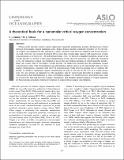| dc.contributor.author | Zakem, Emily Juliette | |
| dc.contributor.author | Follows, Michael J | |
| dc.date.accessioned | 2018-10-02T14:37:54Z | |
| dc.date.available | 2018-10-02T14:37:54Z | |
| dc.date.issued | 2017-03 | |
| dc.date.submitted | 2016-09 | |
| dc.identifier.issn | 0024-3590 | |
| dc.identifier.issn | 1939-5590 | |
| dc.identifier.uri | http://hdl.handle.net/1721.1/118331 | |
| dc.description.abstract | Limnology and Oceanography published by Wiley Periodicals, Inc. on behalf of Association for the Sciences of Limnology and Oceanography When aerobic microbes deplete oxygen sufficiently, anaerobic metabolisms activate, driving losses of fixed nitrogen from marine oxygen minimum zones. Biogeochemical models commonly prescribe a 1–10 μM critical oxygen concentration for this transition, a range consistent with previous empirical and recent theoretical work. However, the recently developed STOX sensor has revealed large regions with much lower oxygen concentrations, at or below its 1–10 nM detection limit. Here, we develop a simplified metabolic model of an aerobic microbe to provide a theoretical interpretation of this observed depletion. We frame the threshold as O*2, the subsistence oxygen concentration of an aerobic microbial metabolism, at which anaerobic metabolisms can coexist with or outcompete aerobic growth. The framework predicts that this minimum oxygen concentration varies with environmental and physiological factors and is in the nanomolar range for most marine environments, consistent with observed concentrations. Using observed grazing rates to calibrate the model, we predict a minimum oxygen concentration of order 0.1–10 nM in the core of a coastal anoxic zone. We also present an argument for why anammox may be energetically favorable at a higher oxygen concentration than denitrification, as some observations suggest. The model generates hypotheses that could be tested in the field and provides a simple, mechanistic, and dynamic parameterization of oxygen depletion for biogeochemical models, without prescription of a fixed critical oxygen concentration. | en_US |
| dc.description.sponsorship | Gordon and Betty Moore Foundation (Grant GBMF3778) | en_US |
| dc.description.sponsorship | Simons Foundation (Grant P49480) | en_US |
| dc.description.sponsorship | United States. National Aeronautics and Space Administration (Grant NNX13AC34G) | en_US |
| dc.description.sponsorship | National Science Foundation (U.S.) (Grant OCE-1259388) | en_US |
| dc.publisher | Association for the Sciences of Limnology and Oceanography | en_US |
| dc.relation.isversionof | http://dx.doi.org/10.1002/LNO.10461 | en_US |
| dc.rights | Creative Commons Attribution 4.0 International License | en_US |
| dc.rights.uri | http://creativecommons.org/licenses/by/4.0/ | en_US |
| dc.source | Association for the Sciences of Limnology and Oceanography (ASLO) | en_US |
| dc.title | A theoretical basis for a nanomolar critical oxygen concentration | en_US |
| dc.type | Article | en_US |
| dc.identifier.citation | Zakem, E. J. and M. J. Follows. “A Theoretical Basis for a Nanomolar Critical Oxygen Concentration.” Limnology and Oceanography 62, 2 (November 2016): 795–805 © 2016 The Authors | en_US |
| dc.contributor.department | Massachusetts Institute of Technology. Department of Earth, Atmospheric, and Planetary Sciences | en_US |
| dc.contributor.mitauthor | Zakem, Emily Juliette | |
| dc.contributor.mitauthor | Follows, Michael J | |
| dc.relation.journal | Limnology and Oceanography | en_US |
| dc.eprint.version | Final published version | en_US |
| dc.type.uri | http://purl.org/eprint/type/JournalArticle | en_US |
| eprint.status | http://purl.org/eprint/status/PeerReviewed | en_US |
| dc.date.updated | 2018-09-24T17:16:34Z | |
| dspace.orderedauthors | Zakem, E. J.; Follows, M. J. | en_US |
| dspace.embargo.terms | N | en_US |
| dc.identifier.orcid | https://orcid.org/0000-0001-6799-5063 | |
| dc.identifier.orcid | https://orcid.org/0000-0002-3102-0341 | |
| mit.license | PUBLISHER_CC | en_US |
